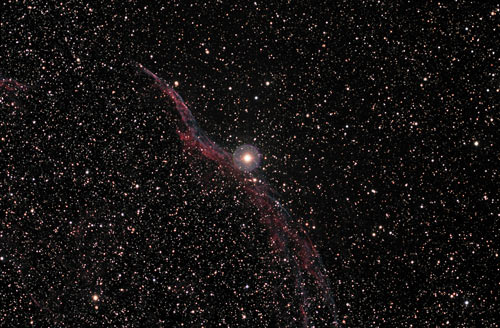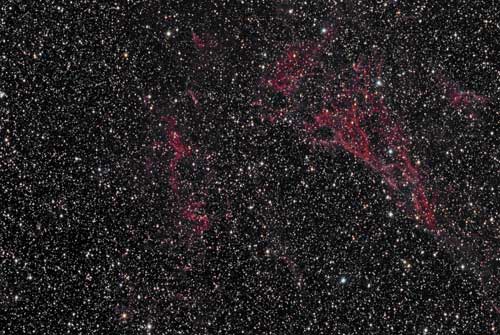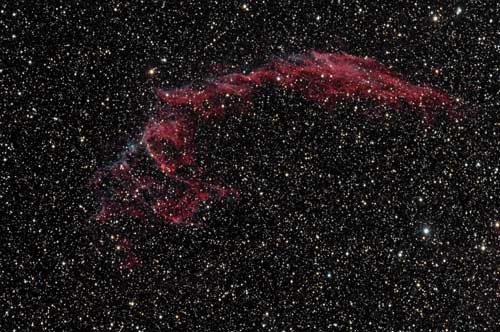|
| |
The Veil Nebula - NGC6960
Image Information
| NGC6960 is commonly known as the Veil Nebula, the Lacework Nebula
and the Cirrus Nebula. The first image in this grouping is also know as
the Witches Broom. The bright star center of this image is 52 Cyg. The
narrow tip of the nebula faces North. The second color image labeled
NGC6920-2 is the NW section of the nebula while the third labeled
NGC6960-3 has it's own designation of NGC6992. At the onset of this
project it was my intent to create a mosaic of this area. It wasn't
until I got into the second image that I realized that the image would
be too large for any great detail as a mosaic. It would also need an
additional two panels that would be nothing more than star fields to
make the image rectangle and that was time I did not have for this
project. The results are 3 separate parts of this complex. I was able to
construct a mosaic from these three panels as there was enough
overlaying star pattern to match. It, however, was not published to this
site due to it's size. |
| Quoted from SEDS
This object is so large (six times the diameter of the Full Moon) that
to earlier observers its brighter parts appeared as a number of distinct
diffuse nebulae, and were assigned e.g. separate NGC numbers, NGC 6960,
NGC 6979, NGC 6992, and NGC 6995; fainter extensions have additional
catalog identities: An extension of Northern part NGC 6979 got the
designation NGC 6974, and an extension of southwestern NGC 6995 was
cataloged as IC 1340. Already
William
Herschel had them as separate objects: H 2.206 = NGC 6979, H 5.14 =
NGC 6992/95, H 5.15 = NGC 6960. Faint luminous material, not cataloged
in NGC or IC, can be found throughout the object's extension.
Despite its overall brightness of about mag 5, this object is only
visible to the naked eye under exceptionally good viewing conditions,
because its light is distributed over the object's large size.
|

800 (165K)
1600
(414K)
Full (586K)

NGC6960-1
800 (165K)
1600
(488K)
Full
(706K)

NGC6960-2
800
1600
Full

(NGC6960-3) NGC6992
800
1600
Full
| Hydrogen Alpha
data collected from July 15 - 19, 2008. Each frame is 30 minutes with a total of
40 frames used giving a
total of 20 hours. Cooler temperature is -15C and full 1X1 binning. Darks
and flats applied. Data acquired using MaxImDl/CCD V5RC1. Processed and
deconvolution using CCDStack. Levels and curves adjusted using Photoshop
CS3. The first RGB image is compiled from 26 - 10 minute R, G,
& B images. A total of 13 hours of data was used. All data was
acquired using MaxImDl/CCD version 4.62 using ACP. Images
were reduced, De-Bloomed, Auto Star Aligned and saved in MaxIm 5.
The data was then brought into MaxImDl where sigma reject was performed
using Russell Crowman's RC Console plug-in to produce the master image
combining the RGB layers into the color image. Photoshop CS 3 was used
for curves and levels. The image data was collected over July 24 -27, 2008.
The second RGB image consists of 25
- 10 minute R, G, & B images and
processed as above. Dates collected July
31 - August 6, 2008.
The third image RGB consists of 23
- 10 minute R, G, & B images and
processed as above. Dates collected July
31 - August 7, 2008.
|
Equipment and Location Information
| Date |
July 24 -27, 2008
July 15 - 19, 2008
July 31 - August 6, 2008
July
31 - August 7, 2008 |
| Location |
Dogwood Ridge Observatory |
| Optics |
Takahashi FSQ-106 |
| Mount |
Astro Physics AP1200GTO |
| Camera |
SBIG ST10XME |
| Conditions |
Temperature middle 60's - low 70's with very
moderate seeing. Transparency good to moderate. |
|
